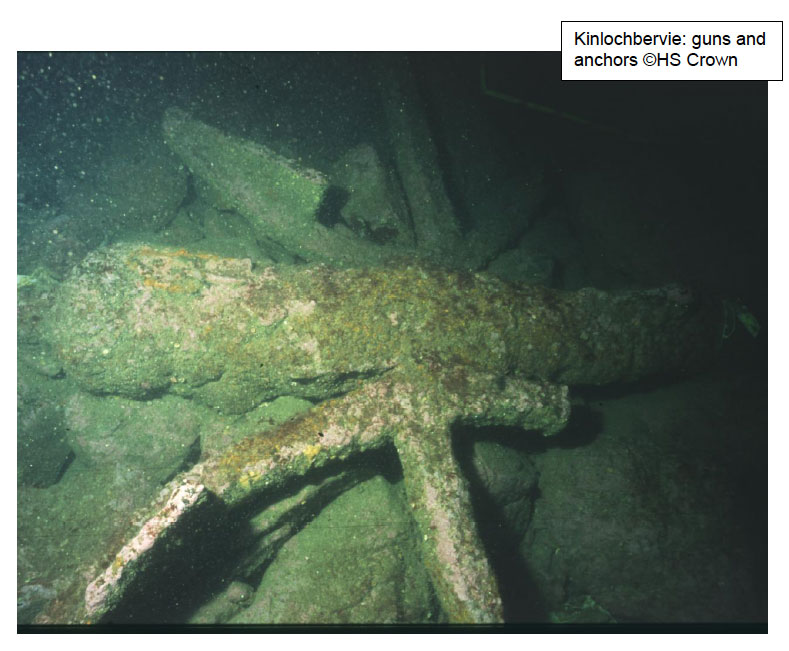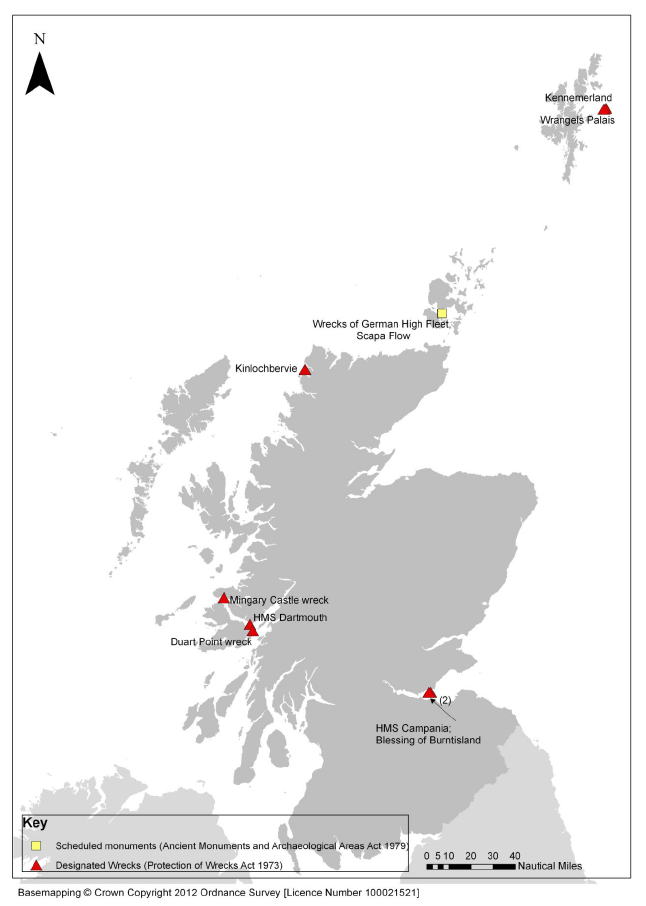Report to the Scottish Parliament on Progress to Identify a Scottish Network of Marine Protected Areas
This reports on which sites are currently included in the MPA network and outlines progress on Nature Conservation MPAs, Historic MPAs, and Demonstration and Research MPAs.
Historic MPAs
Historic Scotland [11] is leading work on Historic MPAs which can be designated within Scottish territorial waters only. Since 2010, Historic Scotland has published Historic MPA guidelines and its operational priorities in a Strategy for the protection, management and promotion of marine heritage 2012-15. This includes an objective of establishing a well-managed group of Historic MPAs in the seas around Scotland. To this end, over the next three years Historic Scotland intends to assess all underwater sites currently designated (under the Protection of Wrecks Act 1973 or the Ancient Monuments and Archaeological Areas Act 1979) and, where appropriate, transfer them to Historic MPA status, as shown in the map in Figure 5. A small number of other high priority sites will be considered for designation. Progress is set out below in Table 2.
Table 2: Progress in identifying Historic MPAs
| Tranche | Provisional recommendations for MPA proposals | Provisional timetable | Progress to date |
|---|---|---|---|
| Tranche 1 - review and where appropriate transition of historic wrecks currently designated under section 1 of the Protection of Wrecks Act 1973 | Progress proposals for
|
Consultation early 2013 | Proposals currently being finalised by Historic Scotland |
| Tranche 2 review and where appropriate transition of historic wrecks currently scheduled under the Ancient Monuments and Archaeological Areas Act 1979 | Scapa Flow - in addition to looking at the existing scheduled German High Seas Fleet wrecks, Historic Scotland will also look at any other priority underwater sites within Scapa Flow relating to the use and defence of the wartime naval anchorage that should be considered for inclusion within a potential Historic MPA | TBC but likely during 2013-14 | In 2011, Orkney Research Centre for Archaeology completed a desk based research exercise to enhance data for Orkney waters; [12] Wessex Archaeology completed a multibeam survey of sites within Scapa Flow, in conjunction with contractors working for the Ministry of Defence. [13] |
| Tranche 3 - any other high priority sites that are currently undesignated | A small number of sites may be recommended for consideration - details to be confirmed in due course. | 2013-2015 | Wessex Archaeology has completed an area assessment of Shetland, and three undesignated site assessments of archaeological sites in the Firth of Forth, Firth of Clyde and Minches which will be used to inform recommendations to Scottish Ministers at the appropriate time |
To underpin decision making in relation to the development of Historic MPA proposals, Historic Scotland commissioned a national study Characterising Scotland's marine archaeological resource (Wessex Archaeology 2011). This study has helped to provide an overview of the known marine archaeological resource, highlighting aspects of particular interest.
Data-sharing with other members of the Scottish MPA project has taken place and where specific archaeological surveys have been needed, these have been commissioned by Historic Scotland, principally through a UK-wide marine archaeology services contract shared with English Heritage, Cadw, and the Department of Environment, Northern Ireland.
Regular stakeholder engagement has taken place, through the Marine Strategy Forum, at workshops arranged by the Built Environment Forum of Scotland and with stakeholders in Orkney. A further workshop on progress with Historic MPAs is being planned to take place in March 2013. In order to promote the new system, Historic Scotland is in the process of updating its website and has published a new leaflet Historic Marine Protected Areas, a guide for visitors, investigators and managers in English and Gaelic.
Although the designation of Historic MPAs contributes to cultural and social values, the Scottish Government has also given consideration as to whether designations by Historic Scotland are likely to contribute to the network for biodiversity or geodiversity. An assessment of the biodiversity value of existing designated wrecks and the Scapa Flow scheduled monuments looked at available data. Most of this has been gathered for archaeological purposes within a very small, confined area of seabed. The report leads Scottish Natural Heritage to conclude that while some designated historic assets and the surrounding seabed may have a level of interest, the biodiversity information currently available for individual sites is probably insufficient to enable an assessment to be made at this stage of a contribution to the network.
It is also recognised that some secondary benefit may be derived for marine historic assets located within the boundaries of Nature Conservation MPAs. A rapid audit by Historic Scotland has indicated that approximately 1220 records of known shipwrecks and documented losses are recorded within the Nature Conservation MPA proposals and search locations provided in this report. The extent to which a secondary benefit is realised will depend largely on the types of features for which each Nature Conservation MPA may be protected in the future, and the extent to which the conservation objectives and subsequent management of that area is also beneficial for cultural heritage. In the future, integrating nature conservation recording objectives alongside archaeological methodology may prove beneficial in supporting more detailed assessments of biodiversity value, and improving understanding of the common ground that exists between nature conservation and heritage protection.

Figure 5: Identifying Historic MPAs - Locations of existing designated wrecks and underwater scheduled monuments

Contact
There is a problem
Thanks for your feedback